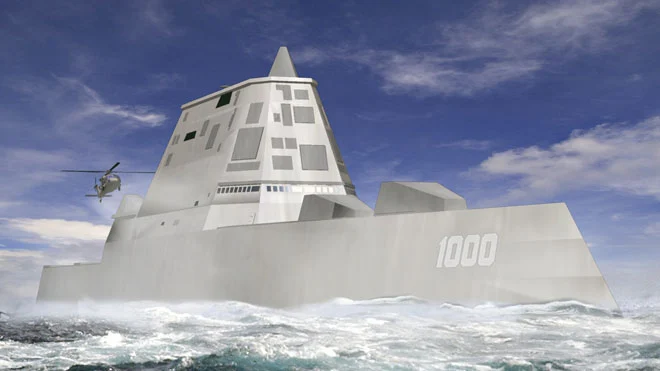The Pentagon has been spending big money for many years now developing stealth technology for the aviation industry.
Indeed, stealth tech helps reduce the radar cross-section of an aircraft – making it difficult for enemy forces to detect and intercept.

Apparently, the US Navy wants some stealth action of its own and plans to kick off construction of an advanced stealth warship. Obviously, this certainly isn’t the first time the Pentagon has toyed with stealth technology for surface ships. To be sure, the Navy infamously tested one stealth ship that inspired a similar craft in a James Bond movie, yet the vessel was ultimately decommissioned and sent to the junkyard in 2011.
The scrapped prototype ship was classified as a catamaran, while the Navy’s new DDG-1000 Zumwalt destroyer boasts a traditional single hull design. If constructed, the US DoD plans on equipping the vessel with next-generation electromagnetic railguns – which uses pure energy to fire projectiles.
Clearly, stealth tech doesn’t come cheap, and each of the next-generation warships will cost $3 billion. As expected, critics of the plan claim the funds can be better used to improve the thinly stretched conventional fleet of surface ships.
Nevertheless, the first of the new breed of destroyers is set to be delivered in 2014, with the Pentagon touting the stealthy ship as the most advanced destroyer in history.
“With its stealth, incredibly capable sonar system, strike capability and lower manning requirements – this is our future,” Adm. Jonathan Greenert, chief of naval operations, said in April after visiting the shipyard in Maine where they are being built.
The DDG-1000 Zumwalt destroyer – armed with advanced sonar and missiles – will boast a special wave piercing hull design that leave virtually no wake, being powered by electric drive propulsion. Interestingly enough, the ships are said to be no heavier than existing destroyers, but will operate with half the required crew thanks to automation (stealth technology allows the large ships to appear about the same size as a small fishing boat on radar).
“Whether the Navy can afford to buy many DDG-1000s must be balanced against the need for over 300 surface ships to fulfill the various missions that confront it,” cautioned Dean Cheng, a China expert with the Heritage Foundation, a conservative research institute in Washington. “Buying hyperexpensive ships hurts that ability, but buying ships that can’t do the job, or worse can’t survive in the face of the enemy, is even more irresponsible.”






